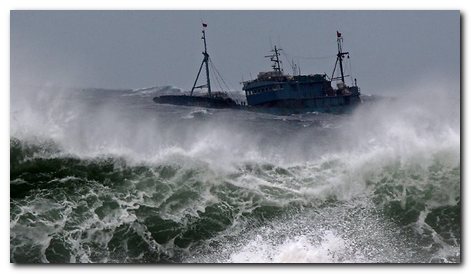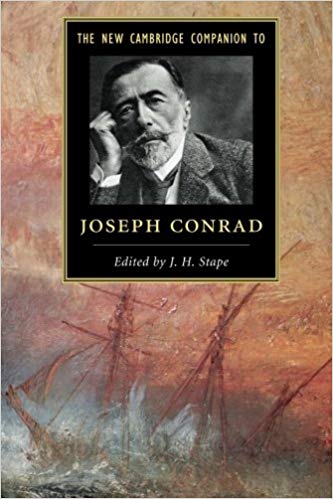tutorial, commentary, study resources, and web links
Typhoon was written between September 1900 and January 1901. It was serialized in Pall Mall Magazine from January to March 1902, and first published in book form by G.P. Putnam’s Sons in New York in September 1902. Conrad repeatedly revised the text for its various English and American appearances. These revisions are a combination of minor matters of spelling and more important changes to the presentation of his two main characters, Jukes and MacWhirr.
Typhoon – critical commentary
The most obvious quality of this tale is the masterful account of the violent storm at sea. Conrad manages to evoke the ferocity and the terrible impact of the hurricane winds, the torrential rain, and the tempestuous seas with strings upon strings of atmospheric synonyms without repeating himself. The ship is convulsed, attacked, and almost destroyed – yet it survives.
The Nan-Shan was being looted by the storm with a senseless, destructive fury: trysails torn out of the extra gaskets, double-lashed awnings blown away, bridge swept clean, weather-cloths burst, rails twisted, light-screens smashed—and two of the boats had gone already. They had gone unheard and unseen, melting, as it were, in the shock and smother of the wave.
The triumph of practicality
At the outset, MacWhirr’s stuffy and unimaginative conservatism and Jukes’ youthful enterprise and enthusiasm are posited as opposing characteristics. MacWhirr reads the maritime manuals on dealing with storms, but chooses to ignore them. Jukes is meanwhile dashing about the ship making sure everything is ready to survive the hurricane.
But as soon as the typhoon really strikes, Jukes thinks everything is lost and he despairs of surviving the experience; whereas MacWhirr simply sticks stubbornly to the ‘right thing’ and finds practical solutions to immediate problems. He does not allow himself to be deflected from the tasks required to maintain order.
When the fighting breaks out amongst the Chinese passengers, MacWhirr despatches Jukes to stop it. When he is attacked by the panicking second mate, he has no hesitation in slugging him. And when the problem of the coolies’ money could threaten their presence in port, he creates a just and simple solution to the problem by dividing the money equally amongst them.
MacWhirr is even cast in quasi-comic form at the outset of the tale – a short man who wears a brown bowler hat and carries an unfurled umbrella, no matter what the weather. But it is his calmness, his taciturn manner, and his meticulous attention to detail which in the end saves his ship, passengers, and crew.
The narrative
Unusually for Conrad, this is a tale cast in third person omniscient narrative mode. He is able to switch freely from one point of view to another as the principal characters move around the ship during the typhoon.
The most impressive piece of narrative manipulation comes in the penultimate section of the tale where, having reached a calm point in the eye of the hurricane, Conrad has the gruff and taciturn MacWhirr realise that having reached this point in the ‘revolving storm’, there is another period of the typhoon the ship has yet to pass through
Before the renewed wrath of winds swooped on his ship, Captain MacWhirr was moved to declare, in a tone of vexation, as it were: “I wouldn’t like to loose her. [the ship]”
He was spared that annoyance.
This is wonderfully ironic understatement and lofty wit – for Conrad does not actually describe the second half of the storm, but immediately pans forward to its aftermath, with the Nan-Shan safely moored in Fu-chau harbour. And there, by describing the uncomprehending responses of the Captain’s and the engineer’s wives to the letters they receive, the toughness and heroism of the mariners is emphasised – as well as by implication, the gulf of comprehension which exists between those who have lived suburban lives on land and those who have braved extreme situations at sea which their loved ones simply could not comprehend.
The form of the narrative
Some features of this work might seem to suggest that it could be regarded as a novella. After all, it has only a few named characters, the very central figure of captain MacWhirr, the action all takes place on board the Nan-Shan, and the storm itself acts as a strongly unifying feature.
But working against such a claim is the fact that there is no necessary connection between the typhoon itself and the skirmish amongst the Chinese workers who are being transported back to the mainland. They form an important but not an integral part of the story. Interestingly enough, it was the plight of these workers (who are referred to as ‘cargo’) which first aroused Conrad’s interest: the typhoon was a secondary issue.
In addition to this, there is no real development, lesson, or outcome in the events. MacWhirr is the same man when he reaches Fu-chau as he was at the beginning – and so is Jukes. So the narrative, for the purposes of classification, seems to me a tale, which can stand with distinction alongside the many others of its kind in Conrad’s oeuvre.
Meteorological note
A typhoon is a ‘severe tropical cyclone’ characterized by a low-pressure center, strong winds, and a spiral arrangement of thunderstorms that produce heavy rain. When these occur in the Northwest Pacific Ocean they are called a typhoon. The same phenomenon occurring in the north Atlantic Ocean is called a hurricane.
Typhoon – study resources
![]() Typhoon – Oxford Classics – Amazon UK
Typhoon – Oxford Classics – Amazon UK
![]() Typhoon – Oxford Classics – Amazon US
Typhoon – Oxford Classics – Amazon US
![]() Typhoon – Penguin Classics – Amazon UK
Typhoon – Penguin Classics – Amazon UK
![]() Typhoon – Penguin Classics – Amazon US
Typhoon – Penguin Classics – Amazon US
![]() The Complete Works of Joseph Conrad – Kindle eBook
The Complete Works of Joseph Conrad – Kindle eBook
![]() Typhoon – eBook versions at Project Gutenberg
Typhoon – eBook versions at Project Gutenberg
![]() Joseph Conrad: A Biography – Amazon UK
Joseph Conrad: A Biography – Amazon UK
![]() The Cambridge Companion to Joseph Conrad – Amazon UK
The Cambridge Companion to Joseph Conrad – Amazon UK
![]() Routledge Guide to Joseph Conrad – Amazon UK
Routledge Guide to Joseph Conrad – Amazon UK
![]() Oxford Reader’s Companion to Conrad – Amazon UK
Oxford Reader’s Companion to Conrad – Amazon UK
![]() Notes on Life and Letters – Amazon UK
Notes on Life and Letters – Amazon UK
![]() Joseph Conrad – biographical notes
Joseph Conrad – biographical notes
Typhoon – plot summary
Part I. Captain MacWhirr is in charge of a newly built steam ship the Nan Shan, which has been transferred from a British to a Siamese flag, with a mixed cargo of goods and two hundred Chinese workers as passengers. They are sailing in the Formosa Strait in the South China Sea bound for Fu-chau, and the barometer is falling.
Part II. MacWhirr is a practical, undemonstrative man of few words. He prepares for what he thinks of as ‘dirty weather’. As the storm gets worse, there is discord in the engine room. Jukes the realistic first mate suggests changing course to avoid the worst of the storm, but MacWhirr stubbornly rejects all known advice in order to avoid altering course (and the cost of the extra fuel it would consume).
Part III. Jukes does his best to prepare the ship for the worst, but when the full force of the hurricane strikes the ship it is so ferocious that he thinks all is lost. He and MacWhirr cling to each other whilst they are pounded by waves and hail. MacWhirr puts his faith in the sound construction of the ship.
Part IV. The bosun arrives with the news that fighting has broken out amongst the Chinese workers below decks. The storm has smashed some wooden sea chests, and dollar coins are spilling loose. He has also discovered that some of the ship’s crew have panicked and are hiding themselves away. MacWhirr despatches Jukes to investigate, which he does reluctantly. Meanwhile, the second mate loses his nerve and panics, forcing MacWhirr s to knock him out. First engineer Rout works heroically in the engine room, from where Jukes reports to the captain.
Part V. In the engine room Jukes is convinced that the ship cannot survive the storm, and the engineer orders him out as a hindrance to his work. Jukes and the bosun take crew members into the bunker where the coolies are trying to get out. The crew subdue the coolies, then lock them in below decks. There is a lull in the hurricane, but MacWhirr realises that being a ‘revolving storm’, there will be a second part to come which could be even worse than the first. He reassures Jukes that by staying attentive, they might come through it.
Part VI. The tale ends with the ship in port at Fu-chau, having survived the second part of the storm. The principal characters are writing back home. On receiving their letters Mrs MacWhirr hopes her husband will remain at sea, and Mrs Laut and her mother similarly have no concept of her husband’s character or heroism. Jukes explains in a letter to his friend how MacWhirr solved the coolie dispute by dividing the dollars equally between them all – so as to create a minimum of trouble.
Typhoon – principal characters
| Captain MacWhirr | a practical man of few words |
| Jukes | his chief mate |
| Solomon Rout | the tall chief engineer |
| — | the ship’s boatswain (not named) |
Joseph Conrad – video biography
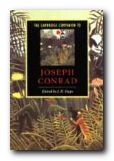 The Cambridge Companion to Joseph Conrad offers a series of essays by leading Conrad scholars aimed at both students and the general reader. There’s a chronology and overview of Conrad’s life, then chapters that explore significant issues in his major writings, and deal in depth with individual works. These are followed by discussions of the special nature of Conrad’s narrative techniques, his complex relationships with late-Victorian imperialism and with literary Modernism, and his influence on other writers and artists. Each essay provides guidance to further reading, and a concluding chapter surveys the body of Conrad criticism.
The Cambridge Companion to Joseph Conrad offers a series of essays by leading Conrad scholars aimed at both students and the general reader. There’s a chronology and overview of Conrad’s life, then chapters that explore significant issues in his major writings, and deal in depth with individual works. These are followed by discussions of the special nature of Conrad’s narrative techniques, his complex relationships with late-Victorian imperialism and with literary Modernism, and his influence on other writers and artists. Each essay provides guidance to further reading, and a concluding chapter surveys the body of Conrad criticism.
![]() Buy the book at Amazon UK
Buy the book at Amazon UK
![]() Buy the book at Amazon US
Buy the book at Amazon US
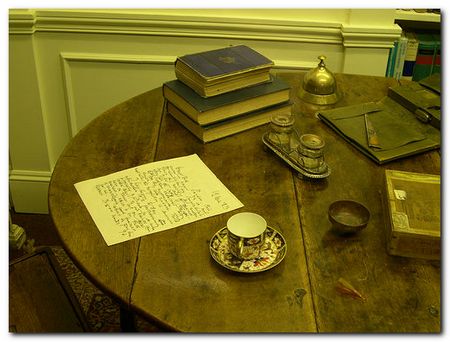
Joseph Conrad’s writing table
Further reading
![]() Amar Acheraiou Joseph Conrad and the Reader, London: Macmillan, 2009.
Amar Acheraiou Joseph Conrad and the Reader, London: Macmillan, 2009.
![]() Jacques Berthoud, Joseph Conrad: The Major Phase, Cambridge: Cambridge University Press, 1978.
Jacques Berthoud, Joseph Conrad: The Major Phase, Cambridge: Cambridge University Press, 1978.
![]() Muriel Bradbrook, Joseph Conrad: Poland’s English Genius, Cambridge: Cambridge University Press, 1941
Muriel Bradbrook, Joseph Conrad: Poland’s English Genius, Cambridge: Cambridge University Press, 1941
![]() Harold Bloom (ed), Joseph Conrad (Bloom’s Modern Critical Views, New York: Chelsea House Publishers, 2010
Harold Bloom (ed), Joseph Conrad (Bloom’s Modern Critical Views, New York: Chelsea House Publishers, 2010
![]() Hillel M. Daleski , Joseph Conrad: The Way of Dispossession, London: Faber, 1977
Hillel M. Daleski , Joseph Conrad: The Way of Dispossession, London: Faber, 1977
![]() Daphna Erdinast-Vulcan, Joseph Conrad and the Modern Temper, Oxford: Oxford University Press, 1991.
Daphna Erdinast-Vulcan, Joseph Conrad and the Modern Temper, Oxford: Oxford University Press, 1991.
![]() Aaron Fogel, Coercion to Speak: Conrad’s Poetics of Dialogue, Cambridge, Mass: Harvard University Press, 1985
Aaron Fogel, Coercion to Speak: Conrad’s Poetics of Dialogue, Cambridge, Mass: Harvard University Press, 1985
![]() John Dozier Gordon, Joseph Conrad: The Making of a Novelist, Cambridge, Mass: Harvard University Press, 1940
John Dozier Gordon, Joseph Conrad: The Making of a Novelist, Cambridge, Mass: Harvard University Press, 1940
![]() Albert J. Guerard, Conrad the Novelist, Cambridge, Mass: Harvard University Press, 1958
Albert J. Guerard, Conrad the Novelist, Cambridge, Mass: Harvard University Press, 1958
![]() Robert Hampson, Joseph Conrad: Betrayal and Identity, Basingstoke: Macmillan, 1992
Robert Hampson, Joseph Conrad: Betrayal and Identity, Basingstoke: Macmillan, 1992
![]() Jeremy Hawthorn, Joseph Conrad: Language and Fictional Self-Consciousness, London: Edward Arnold, 1979
Jeremy Hawthorn, Joseph Conrad: Language and Fictional Self-Consciousness, London: Edward Arnold, 1979
![]() Jeremy Hawthorn, Joseph Conrad: Narrative Technique and Ideological Commitment, London: Edward Arnold, 1990
Jeremy Hawthorn, Joseph Conrad: Narrative Technique and Ideological Commitment, London: Edward Arnold, 1990
![]() Jeremy Hawthorn, Sexuality and the Erotic in the Fiction of Joseph Conrad, London: Continuum, 2007.
Jeremy Hawthorn, Sexuality and the Erotic in the Fiction of Joseph Conrad, London: Continuum, 2007.
![]() Owen Knowles, The Oxford Reader’s Companion to Conrad, Oxford: Oxford University Press, 1990
Owen Knowles, The Oxford Reader’s Companion to Conrad, Oxford: Oxford University Press, 1990
![]() Jakob Lothe, Joseph Conrad: Voice, Sequence, History, Genre, Ohio State University Press, 2008
Jakob Lothe, Joseph Conrad: Voice, Sequence, History, Genre, Ohio State University Press, 2008
![]() Gustav Morf, The Polish Shades and Ghosts of Joseph Conrad, New York: Astra, 1976
Gustav Morf, The Polish Shades and Ghosts of Joseph Conrad, New York: Astra, 1976
![]() Ross Murfin, Conrad Revisited: Essays for the Eighties, Tuscaloosa, Ala: University of Alabama Press, 1985
Ross Murfin, Conrad Revisited: Essays for the Eighties, Tuscaloosa, Ala: University of Alabama Press, 1985
![]() Jeffery Myers, Joseph Conrad: A Biography, Cooper Square Publishers, 2001.
Jeffery Myers, Joseph Conrad: A Biography, Cooper Square Publishers, 2001.
![]() Zdzislaw Najder, Joseph Conrad: A Life, Camden House, 2007.
Zdzislaw Najder, Joseph Conrad: A Life, Camden House, 2007.
![]() George A. Panichas, Joseph Conrad: His Moral Vision, Mercer University Press, 2005.
George A. Panichas, Joseph Conrad: His Moral Vision, Mercer University Press, 2005.
![]() John G. Peters, The Cambridge Introduction to Joseph Conrad, Cambridge: Cambridge University Press, 2006.
John G. Peters, The Cambridge Introduction to Joseph Conrad, Cambridge: Cambridge University Press, 2006.
![]() James Phelan, Joseph Conrad: Voice, Sequence, History, Genre, Ohio State University Press, 2008.
James Phelan, Joseph Conrad: Voice, Sequence, History, Genre, Ohio State University Press, 2008.
![]() Edward Said, Joseph Conrad and the Fiction of Autobiography, Cambridge Mass: Harvard University Press, 1966
Edward Said, Joseph Conrad and the Fiction of Autobiography, Cambridge Mass: Harvard University Press, 1966
![]() Allan H. Simmons, Joseph Conrad: (Critical Issues), London: Macmillan, 2006.
Allan H. Simmons, Joseph Conrad: (Critical Issues), London: Macmillan, 2006.
![]() J.H. Stape, The Cambridge Companion to Joseph Conrad, Cambridge: Cambridge University Press, 1996
J.H. Stape, The Cambridge Companion to Joseph Conrad, Cambridge: Cambridge University Press, 1996
![]() John Stape, The Several Lives of Joseph Conrad, Arrow Books, 2008.
John Stape, The Several Lives of Joseph Conrad, Arrow Books, 2008.
![]() Peter Villiers, Joseph Conrad: Master Mariner, Seafarer Books, 2006.
Peter Villiers, Joseph Conrad: Master Mariner, Seafarer Books, 2006.
![]() Ian Watt, Conrad in the Nineteenth Century, London: Chatto and Windus, 1980
Ian Watt, Conrad in the Nineteenth Century, London: Chatto and Windus, 1980
![]() Cedric Watts, Joseph Conrad: (Writers and their Work), London: Northcote House, 1994.
Cedric Watts, Joseph Conrad: (Writers and their Work), London: Northcote House, 1994.
Other writing by Joseph Conrad
 Lord Jim (1900) is the earliest of Conrad’s big and serious novels, and it explores one of his favourite subjects – cowardice and moral redemption. Jim is a ship’s captain who in youthful ignorance commits the worst offence – abandoning his ship. He spends the remainder of his adult life in shameful obscurity in the South Seas, trying to re-build his confidence and his character. What makes the novel fascinating is not only the tragic but redemptive outcome, but the manner in which it is told. The narrator Marlowe recounts the events in a time scheme which shifts between past and present in an amazingly complex manner. This is one of the features which makes Conrad (born in the nineteenth century) considered one of the fathers of twentieth century modernism.
Lord Jim (1900) is the earliest of Conrad’s big and serious novels, and it explores one of his favourite subjects – cowardice and moral redemption. Jim is a ship’s captain who in youthful ignorance commits the worst offence – abandoning his ship. He spends the remainder of his adult life in shameful obscurity in the South Seas, trying to re-build his confidence and his character. What makes the novel fascinating is not only the tragic but redemptive outcome, but the manner in which it is told. The narrator Marlowe recounts the events in a time scheme which shifts between past and present in an amazingly complex manner. This is one of the features which makes Conrad (born in the nineteenth century) considered one of the fathers of twentieth century modernism.
![]() Buy the book from Amazon UK
Buy the book from Amazon UK
![]() Buy the book from Amazon US
Buy the book from Amazon US
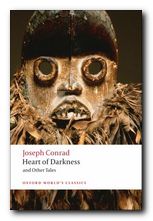 Heart of Darkness (1902) is a tightly controlled novella which has assumed classic status as an account of the process of Imperialism. It documents the search for a mysterious Kurtz, who has ‘gone too far’ in his exploitation of Africans in the ivory trade. The reader is plunged deeper and deeper into the ‘horrors’ of what happened when Europeans invaded the continent. This might well go down in literary history as Conrad’s finest and most insightful achievement, and it is based on his own experiences as a sea captain. This volume also contains ‘An Outpost of Progress’ – the magnificent study in shabby cowardice which prefigures ‘Heart of Darkness’.
Heart of Darkness (1902) is a tightly controlled novella which has assumed classic status as an account of the process of Imperialism. It documents the search for a mysterious Kurtz, who has ‘gone too far’ in his exploitation of Africans in the ivory trade. The reader is plunged deeper and deeper into the ‘horrors’ of what happened when Europeans invaded the continent. This might well go down in literary history as Conrad’s finest and most insightful achievement, and it is based on his own experiences as a sea captain. This volume also contains ‘An Outpost of Progress’ – the magnificent study in shabby cowardice which prefigures ‘Heart of Darkness’.
![]() Buy the book from Amazon UK
Buy the book from Amazon UK
![]() Buy the book from Amazon US
Buy the book from Amazon US
© Roy Johnson 2014
Joseph Conrad links
Joseph Conrad at Mantex
Biography, tutorials, book reviews, study guides, videos, web links.
Joseph Conrad – his greatest novels and novellas
Brief notes introducing his major works in recommended editions.
Joseph Conrad at Project Gutenberg
A major collection of free eTexts in a variety of formats.
Joseph Conrad at Wikipedia
Biography, major works, literary career, style, politics, and further reading.
Joseph Conrad at the Internet Movie Database
Adaptations for the cinema and television – in various languages. Full details of directors and actors, production notes, box office, trivia, and quizzes.
Works by Joseph Conrad
Large online database of free HTML texts, digital scans, and eText versions of novels, stories, and occasional writings.
The Joseph Conrad Society (UK)
Conradian journal, reviews. and scholarly resources.
The Joseph Conrad Society of America
American-based – recent publications, journal, awards, conferences.
Hyper-Concordance of Conrad’s works
Locate a word or phrase – in the context of the novel or story.
More on Joseph Conrad
Twentieth century literature
Joseph Conrad complete tales
